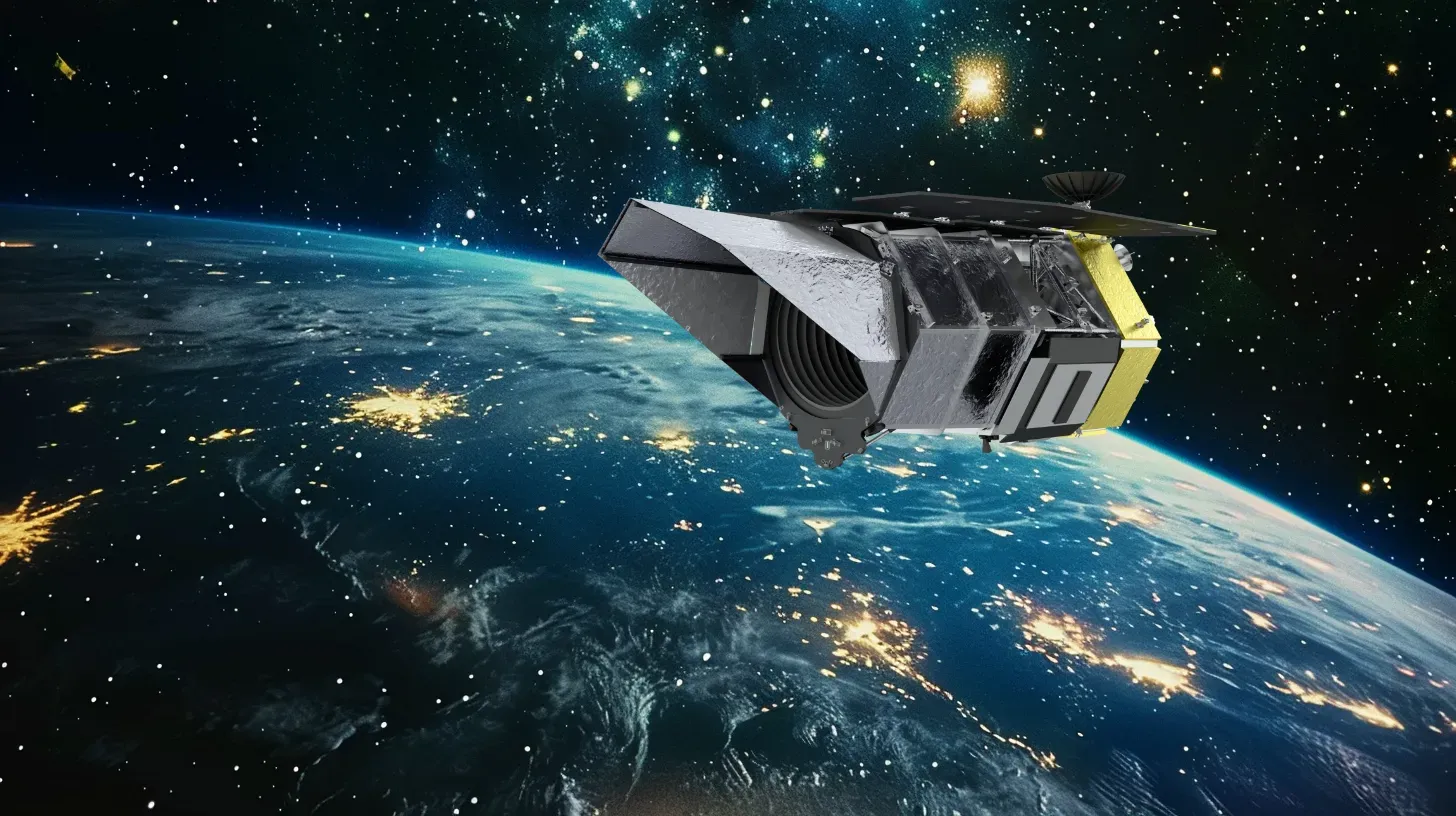By 2027, The Nancy Grace Roman Telescope will Unlock Cosmic Secrets #Trend
Discover the trend reshaping space exploration: the Nancy Grace Roman Space Telescope. Launching by 2027, it will unveil cosmic mysteries, from dark energy to exoplanets. With cutting-edge tech, it promises a new era of discovery. Ready to explore the stars? Dive in! 🌌🔭

Picture this: you're lying on a grassy hill, gazing up at the night sky, pondering the mysteries of the universe. What if I told you that just a few years from now, a new eye in the sky will be doing much the same—only it will be equipped with technology that could reveal cosmic secrets we’ve only dreamed about? Meet the Nancy Grace Roman Space Telescope, an astronomical game-changer poised to make Hubble look like a quaint old telescope from grandma's attic. 🚀🔭 #SpaceRevolution
Named after NASA's first Chief of Astronomy, Nancy Grace Roman, this telescope is set to embark on a journey that could redefine what we know about the universe. Imagine a camera with a view so broad it makes Hubble's images look like tiny snapshots. With its Wide Field Instrument, the Roman Space Telescope will capture images 100 times larger than Hubble's, allowing us to explore the cosmos like never before. And it’s not just about size; this telescope will delve into the enigmatic realms of dark matter and dark energy, those elusive cosmic ingredients that make scientists' hair stand on end. 🌌 #AstronomyGoals
In this blog, we’ll take you on an interstellar adventure, exploring the history of this groundbreaking project, its current development hurdles, and the mind-boggling future it promises to unveil. From the nuts and bolts of its cutting-edge technology to the scientific breakthroughs it aims to achieve, join us as we embark on a celestial journey that will illuminate the cosmos and our place within it. Ready to unlock the universe’s mysteries with us? Let’s dive into the awe-inspiring world of the Nancy Grace Roman Space Telescope. 🌠 #CosmicJourney
Nancy Grace Roman Space Telescope: Unveiling the Universe's Secrets 🌌🔭
The Nancy Grace Roman Space Telescope is a revolutionary astronomical observatory poised to transform our understanding of the universe. Named in honor of Nancy Grace Roman, NASA's first Chief of Astronomy and a key figure behind the Hubble Space Telescope, this cutting-edge telescope is designed to capture images 100 times larger than those of the Hubble. With its expansive field of view, the Roman Space Telescope will allow us to survey vast areas of the sky with unprecedented detail. 🌠
Central to the Roman Space Telescope's capabilities is its Wide Field Instrument (WFI). This powerful tool will enable astronomers to conduct comprehensive surveys of galaxies, stars, and other celestial phenomena, offering insights into the universe's structure and evolution. The WFI is particularly adept at detecting faint objects, making it an invaluable asset for studying dark matter and dark energy—two of the cosmos's most enigmatic components. #Astronomy
Technological Marvels for Cosmic Discovery
The Roman Space Telescope is equipped with state-of-the-art technology that sets it apart from its predecessors. Among its standout features is the Coronagraph instrument, designed to block out starlight, allowing scientists to directly image planets orbiting distant stars. This technology will enable the study of exoplanets in extraordinary detail, potentially revealing their atmospheres and even signs of habitability. Imagine spotting a firefly next to a spotlight from thousands of miles away—that's the level of precision we're talking about! 🔭
Another remarkable capability of the Roman Space Telescope is its proficiency in infrared observations. Infrared light can penetrate dust clouds that obscure visible light, unveiling hidden regions of space. This ability will allow astronomers to study star formation, the centers of galaxies, and other phenomena that are otherwise shrouded in mystery. By observing in the infrared spectrum, the Roman Space Telescope will provide a clearer picture of the universe's hidden structures. #InfraredAstronomy
Mapping the Cosmos: A New Perspective
With its wide-field capabilities, the Roman Space Telescope is a formidable tool for conducting large-scale surveys of the universe. These surveys will enable scientists to map the distribution of galaxies across vast cosmic distances, shedding light on the large-scale structure of the universe. By studying the distribution of galaxies, astronomers can gain insights into the nature of dark matter and dark energy, which together constitute about 95% of the universe's total mass-energy content. 🌌
Beyond its scientific objectives, the Roman Space Telescope will serve as a pathfinder for future space missions. Its advanced technologies and innovative design will pave the way for the next generation of space telescopes, helping to refine techniques for observing the universe. The data collected by the Roman Space Telescope will be invaluable for planning future missions, ensuring that we continue to push the boundaries of our cosmic knowledge. #SpaceExploration
The Nancy Grace Roman Space Telescope represents a significant leap forward in our ability to study the universe. With its wide-field imaging capabilities, advanced coronagraph, and infrared observations, it promises to unlock new mysteries of the cosmos and deepen our understanding of the fundamental forces shaping our universe. As we prepare to explore the universe with this remarkable instrument, we are on the brink of a new era in astronomy, one that promises to transform our view of the cosmos forever. 🚀
The Nancy Grace Roman Space Telescope: A Visionary Journey Through Time 🌌
The inception of the Nancy Grace Roman Space Telescope traces back to the early 2010s, when NASA envisioned a mission that would delve into the mysteries of dark energy, exoplanets, and infrared astrophysics. Originally named the Wide Field Infrared Survey Telescope (WFIRST), this ambitious project was a response to the National Research Council's 2010 Decadal Survey, which emphasized the need for a wide-field infrared survey mission. The goal was to extend the legacy of the Hubble and James Webb Space Telescopes by offering a broader view of the universe. 🚀 #SpaceExploration
In 2020, the project was renamed to honor Dr. Nancy Grace Roman, NASA's first Chief of Astronomy. Known as the "Mother of Hubble", Roman was a trailblazer in space science, advocating for the development of space telescopes that could transform our understanding of the cosmos. Her pioneering efforts laid the groundwork for future missions, making her an ideal namesake for this next-generation telescope. The renaming not only celebrated her contributions but also underscored the telescope's mission to continue her legacy of groundbreaking astronomical research. 👩🚀 #WomenInScience
Development and Challenges
The development of the Nancy Grace Roman Space Telescope was not without its hurdles. Budgetary constraints and technical challenges initially threatened to delay the project. However, the scientific community and NASA remained steadfast, recognizing the telescope's potential to answer fundamental questions about the universe. The telescope's design features a 2,4-meter primary mirror and two main instruments: the Wide Field Instrument and the Coronagraph Instrument, both promising to deliver unprecedented data. 🔭 #SpaceTech
The journey of the Roman Space Telescope has been marked by collaboration among multiple institutions and international partners. This cooperative effort has been crucial in overcoming obstacles and advancing the project toward its anticipated launch. The telescope's evolution from concept to construction is a testament to human ingenuity and the relentless pursuit of knowledge. 🌟 #AstronomyHistory

The Current State of the Nancy Grace Roman Space Telescope: Unveiling the Universe's Secrets 🚀
The Nancy Grace Roman Space Telescope is currently captivating the scientific community as it approaches its eagerly awaited launch. This state-of-the-art observatory, named in honor of NASA's first Chief of Astronomy, is poised to tackle some of the universe's most profound mysteries. Presently, the telescope is in the final stages of development, with a dedicated team of engineers and scientists ensuring its readiness for space. Its sophisticated instruments promise to deliver groundbreaking insights into dark energy, exoplanets, and infrared astrophysics, heralding a new era in our cosmic understanding. 🌌 #SpaceInnovation
One of the telescope's standout features is its Wide Field Instrument, boasting a field of view 100 times greater than that of the Hubble Space Telescope. This capability will empower astronomers to conduct extensive surveys of the universe, capturing vast swathes of the sky in exquisite detail. The Roman Telescope's infrared observation capabilities will allow it to peer through cosmic dust clouds, unveiling hidden structures and phenomena. This makes it an invaluable tool for studying galaxy formation, stellar evolution, and the lifecycle of stars. 🔭 #AstronomyRevolution
Global Collaborations and Educational Impact
The Roman Space Telescope is fostering international collaborations, with scientists from around the world contributing to its mission. These partnerships are essential for maximizing the telescope's potential, as they bring together diverse expertise and resources. The data collected will be shared with the global scientific community, promoting open access and collaborative research. This approach is expected to accelerate discoveries and innovations in space science, benefiting humanity as a whole. 🌍 #GlobalScience
Beyond its scientific objectives, the Roman Space Telescope is set to inspire a new generation of space enthusiasts and researchers. Educational programs and outreach initiatives are being developed to engage students and the public, showcasing the telescope's capabilities and the wonders of the universe. By sparking curiosity and interest in space exploration, these efforts aim to cultivate the next wave of astronomers and engineers who will continue to push the boundaries of our cosmic knowledge. 🌠 #STEMEducation
Challenges and Current Limitations
Despite its promising potential, the Roman Space Telescope faces several challenges as it nears launch. One primary concern is the complexity of its instruments, which require meticulous testing and calibration to ensure optimal performance in space. Additionally, the project must navigate budget constraints and logistical hurdles, common in large-scale space missions. However, the dedicated teams at NASA and their partners are committed to overcoming these obstacles, driven by the telescope's potential to transform our understanding of the universe. 💪 #SpaceChallenges
Another limitation is the telescope's reliance on existing launch vehicles, which can introduce uncertainties in scheduling and costs. The mission's success hinges on the timely and safe deployment of the telescope into its designated orbit. Nevertheless, with careful planning and coordination, the Roman Space Telescope is on track to become a cornerstone of modern astrophysics, offering insights that could redefine our place in the universe. 🚀 #SpaceExploration
The Future of the Nancy Grace Roman Space Telescope: Charting New Cosmic Frontiers 🚀🔭
The Nancy Grace Roman Space Telescope is set to embark on a groundbreaking journey, poised to transform our understanding of the universe. Scheduled for launch in the mid-2020s, this state-of-the-art observatory will capture the cosmos with unparalleled precision. Its wide-field imaging capabilities will allow us to survey vast swathes of the sky, offering insights into the enigmatic nature of dark energy and the universe's expansion. With its advanced technology, the Roman Space Telescope is expected to discover thousands of new exoplanets, potentially identifying Earth-like worlds in habitable zones. 🌌 #SpaceExploration #CosmicDiscovery
In the initial years post-launch, the Roman Space Telescope will focus on calibrating its instruments and capturing its first images, a moment eagerly anticipated by astronomers worldwide. These early observations will lay the groundwork for groundbreaking discoveries, offering fresh perspectives on distant galaxies and the mysterious forces shaping our universe. The data collected will be invaluable, providing a foundation for future research and exploration. 🌠 #FirstLight #Astronomy
Scientific Breakthroughs on the Horizon
Looking further ahead, the Roman Space Telescope is expected to make significant contributions to our understanding of dark matter and dark energy. By mapping the distribution of galaxies across the universe, it will help us unravel the mysteries of these elusive phenomena. This research could lead to major scientific breakthroughs, potentially reshaping our understanding of the fundamental forces that govern the cosmos. As we delve deeper into these cosmic mysteries, the Roman Space Telescope will serve as a beacon of discovery, guiding us toward new horizons. 🌌 #DarkMatter #ScientificDiscovery
In addition to its contributions to cosmology, the Roman Space Telescope will play a crucial role in the search for exoplanets. Its ability to detect and characterize distant worlds will enhance our understanding of planetary systems beyond our own. By identifying potentially habitable exoplanets, the telescope will spark new questions about the possibility of life elsewhere in the universe. This quest for knowledge will inspire future generations of astronomers and scientists, driving innovation and exploration. 🌍 #ExoplanetResearch #Astrobiology
Extended Missions and Collaborative Efforts
As the Roman Space Telescope continues its mission, collaborations with other space agencies and observatories will enhance its scientific output. These partnerships will enable the sharing of data and resources, leading to more comprehensive studies and discoveries. The telescope's extended mission will allow it to operate beyond its initial lifespan, ensuring that its contributions to astronomy and astrophysics continue for decades to come. 🛰️ #SpaceCollaboration #ExtendedMission
Beyond its operational phase, the legacy of the Roman Space Telescope will endure through its vast archive of data. This treasure trove of information will be a cornerstone for future research, providing insights into galaxy formation, cosmic evolution, and more. As scientists continue to analyze this data, new discoveries will emerge, furthering our understanding of the universe and its myriad wonders. 📚 #AstronomicalLegacy #FutureResearch
Inspiring Future Explorations
The impact of the Roman Space Telescope will extend beyond scientific discoveries, inspiring future generations of astronomers, engineers, and explorers. Its success will pave the way for new missions and technologies, driving the next wave of space exploration. As we look to the stars, the Roman Space Telescope will serve as a testament to humanity's enduring quest to understand the universe, encouraging us to reach for the unknown. 🌟 #Inspiration #FutureExplorations
Revealing the Cosmos: Are You Ready for the Roman Revolution? 🌌🔭
As we prepare to launch into the next chapter of space exploration, the Nancy Grace Roman Space Telescope stands ready to transform our cosmic view. This technological marvel, equipped with its Wide Field Instrument and Coronagraph, is set to unravel mysteries of dark matter, dark energy, and distant worlds like never before. From its expansive surveys that dwarf Hubble's capabilities to its potential to spot Earth-like exoplanets, the Roman Telescope promises discoveries that could reshape our understanding of the universe. 🚀 #SpaceRevolution
Just as we began by imagining gazing at the stars, the Roman Space Telescope will offer humanity a profound new perspective, inviting us to ponder our place in the cosmos. This mission isn't just a leap for astronomy; it's a giant step for human curiosity and understanding. 🤓
So, are you ready to join the cosmic journey? Share your thoughts in the comments, explore our related resources, and subscribe for updates as we continue to venture into the universe's vast unknown. Together, let's unlock the secrets of the stars! 🌠 #CosmicJourney #JoinTheExploration
Timeline Projections: The Future of the Nancy Grace Roman Space Telescope 🌠🔭
- 2027 - Launch and Early Operations: The Nancy Grace Roman Space Telescope is successfully launched, marking the beginning of a new era in space exploration. Initial operations focus on calibrating instruments and system checks. 🚀 #SpaceLaunch
- 2027-2030 - First Light and Initial Discoveries: The telescope captures its first stunning images of the cosmos, revealing unprecedented details of distant galaxies and exoplanets. Early data provides new insights into dark energy and helps identify numerous potential exoplanets. 🌌✨ #FirstLight
- 2030-2040 - Major Scientific Breakthroughs: The telescope's observations lead to significant advancements in our understanding of the universe's expansion and the nature of dark matter. Discoveries may include Earth-like exoplanets within habitable zones, sparking excitement about potential life beyond our solar system. 🌍🔭 #CosmicDiscovery
- 2040-2050 - Extended Mission and Collaborations: Due to its success, the mission is extended, and the telescope continues to operate beyond its expected lifespan. Collaborations with other space agencies and telescopes enhance data collection and analysis, leading to even more groundbreaking discoveries. 🛰️🤝 #ExtendedMission
- 2050-2075 - Legacy and Ongoing Impact: The wealth of data collected becomes a cornerstone for astronomical research. Scientists continue to make discoveries using the telescope's archives, influencing studies on galaxy formation, cosmic evolution, and potentially identifying signals that could indicate extraterrestrial life. 📚🌠 #AstronomicalLegacy
- Beyond 2075 - Inspiration for Future Explorations: The telescope's enduring impact inspires future generations of astronomers and engineers. Its legacy influences the design of new missions and technologies aimed at exploring the cosmos even further. 🚀🌟 #FutureExplorations
The Nancy Grace Roman Space Telescope's journey exemplifies humanity's quest to understand the universe. As we look to the future, its contributions will continue to inspire and guide astronomical discoveries for decades to come. 🌌🔮
References: * Stargazing with Nancy: The Roman Space Odyssey Awaits! 🚀🔭
- “Nancy Grace Roman Space Telescope - NASA” — https://roman.gsfc.nasa.gov/
- “What is the Nancy Grace Roman Space Telescope?” — https://www.space.com/nancy-grace-roman-space-telescope
- “Why the Roman Space Telescope?” — https://science.nasa.gov/mission/roman-space-telescope/why-the-roman-space-telescope/
- “Navigating the Nancy Grace Roman Space Telescope” — https://www.northropgrumman.com/space/navigating-the-nancy-grace-roman-space-telescope

